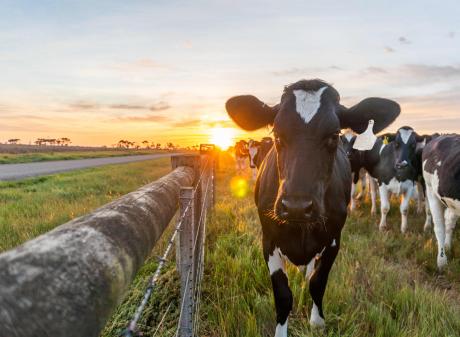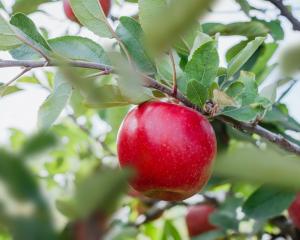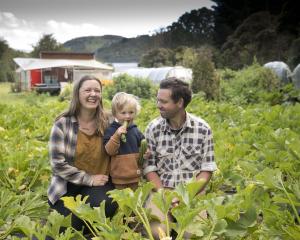
Conventional cherry trees are on the way out, a Central Otago cherry growing adviser says.
The Ministry for Primary Industries report "Situation and Outlook for Primary Industries" released last month said the New Zealand cherry industry achieved a record export revenue of $92million for the season ending March 31 this year, up 10% on the previous season.
The outlook for New Zealand’s cherry industry was positive and export quantity was forecast to grow 3% to 3930 tons for the season ending June next year, the report says.
"New large-scale corporate blocks are coming into production and the industry continues to look towards new technology to help strengthen productivity. An example is a new planting system being trialled in Central Otago," the report says.
Meet Central Otago cherry growing adviser Earnscy Weaver, who introduced a new cherry growing system to New Zealand.
The upright fruiting offshoot (UFO) system was developed in the United States.
In the system, cherry trees are planted on a 45-degree angle and branches are pruned to leave uprights.
The system brings orchard rows closer in a two-dimensional structure to achieve even light penetration across the whole canopy, producing uniform high-quality fruit.
In the UFO system, rows of trees are 3m-apart, closer than conventional rows.
"At the end of the day all we are doing is harvesting light — without the light you can’t grow anything and you’ve got to maximise it."
Mr Weaver heard United States horticulturist Dr Matt Whiting speak about the UFO system at a conference in Tasmania in 2008.
On returning to Central Otago, he contacted 45 South chief executive Tim Jones, one of New Zealand’s biggest cherry exporters, Mr Weaver said.
Mr Jones allowed for one row of cherry trees to be planted in the UFO system in an orchard in Cromwell.
The trial developed and proved the system worked.

Conventional cherry trees were "becoming unsustainable" because they promoted system inefficiencies, such as requiring staff to climb high on ladders to pick fruit and prune branches.
Branches in a UFO system could be easily pruned by an unskilled backpackers because it was a simple system similar to paint by numbers or "prune-by-numbers", he said.
"You can’t do that with the old conventional trees because there is a bit of an art form to it."
Other benefits of the UFO system include fewer cherries cracking because the fruit is covered by leaves on upright branches, which provide rain protection.
Fewer cherries are damaged by birds in a UFO system because upright branches give birds nothing to stand on when eating.
Crown research institute Plant & Food Research designed a variation, the Future Orchard Planting System (FOPS) and promoted trees being planted 2m apart for productivity and efficiency gains.
Mr Weaver estimated up to 400ha of cherries in about 20 orchards used a mix of features from the UFO and FOPS systems in Central Otago, including his 2ha orchard in Springvale near Alexandra.
He and his wife Irene planted the block on their "commercial lifestyle block" about eight years ago. "This is fun and it enough to be commercial."
The orchard generates about $600,000 gross income.
Reasons for growing cherries over another type of fruit was the challenge and the financial return, he said.
Apricots were his favourite fruit but cherries were chosen because much more information was available on how to grow a commercial crop due to the more extensive research on the fruit.
He was continually investigating ways to grow a better cherry crop.
A rain cover was installed in the orchard to reduce wastage.
"I spent too many years losing crop to rain. You work your guts out for 11 months and 28 days and then it rains and bang, you’ve lost it. It is absolutely cruel."

He was constantly trialling inputs and some worked better than others — "there is snake oils".
Products proven to work on his orchard include reflective mulch and liquid fertiliser.
Learning about new technology to improve a crop kept the work "fun and worthwhile to get up in the morning", he said.
He had been growing fruit most of his life and was always learning, including attending international cherry symposiums and reading the latest research.
"You pedal hard to keep up as this game keeps changing rapidly."
In his orchard, he plants rows of trees 2m apart, as Plant & Food Research recommends.
However, he found 2m between rows to be "tight".
In hindsight, he would have planted the rows 2.25m apart to provide more room for driving machinery.
"I get in here and I’m too busy looking at trees and drive into poles."
An orchard planted in UFO system could contain twice as many trees as a conventional system, he said.
Consequently, a disadvantage of installing an UFO system was increased capital cost to establish an orchard including twice as many trees, poles and wires.
"You’ve got to get your return on capital out of it but man, it pays back."
The cherry industry in Central Otago was part of a boom-and-bust cycle and he believed the industry was on its way down.
He said cherry growers needed to be producing a fruit 30mm or bigger to fetch a market premium and remain profitable.

All crops "hit a wall" and cherries are not exempt.
He once believed the cherry industry would hit the wall in the early 2000s and "it is still rolling on".
For the cherry industry to avoid hitting the wall, growers had to produce "large, hard, fresh and flavourful" fruit to ensure export demand endures.
Growers must strive to continually improve the quality of their fruit — "If we keep doing what we are doing now, we are going to get left behind so we have to keep growing and that’s the challenge."
New Zealand exports nearly 4000 ton of cherries. In comparison, Chile exports about 500,000 ton of cherries.
As New Zealand’s cherry industry was much smaller, it had an opportunity to be better, as the bigger an industry, the harder it could become to consistently supply high-quality fruit.
New Zealand produces some of the best and some of the worst cherries in the world.
In the past, a mix of quality cherries were exported but improvements had been made in this area.
New Zealand growers needed to adopt any new technology available, such as the UFO system, to remain competitive in the export market, he said.
As some countries produce much more cherries than New Zealand, they had better access to products such as pesticides, which gave them an advantage.
For example, international pesticide producers do not sell a type of fungicide in New Zealand, which controls rot in cherry trees.
A UFO system would allow for better use of technology being developed than a conventional cherry tree.
The technology includes capturing images of cherry trees to produce data, such as potential fruit yield.
Cherry trees in a UFO system were easier to prune and pick and would be easier for a robot to work on than a conventional cherry tree.

"You’d programme them up and let them loose in your block and they’d know what colour, size and firmness to pick to."
New cherry varieties were being developed to produce bigger and harder fruit, he said.
New Zealand growers need to be ready to introduce the varieties when they become available to remain competitive in export markets.
Mr Weaver was the third generation of his family to grow fruit in Central Otago.
His grandfather Charles Weaver was dredging for gold and when that industry was winding down, planted an orchard in Earnscleugh in the early 1900s.
The orchard stayed in the family and Earnscy took it over after finishing at Lincoln University.
"When I got home from Lincoln I knew it all and my old man Earnscy told me I didn’t and he was right. I know less now than I knew then" he laughs.
The family orchard was sold to corporate Summerfruit Orchards and he worked for them and then corporate Molyneux Holdings.
He launched his consulting business in the early 2000s, helping clients establish orchards, troubleshoot and trial growing systems.
His clients included cherry growers in Australia and China.
New Zealand cherry growers could be critical of him providing advice to international orchardists who supply the export market at the same time of the year, such as Tasmania.
"I took a bit of s..t but it didn’t worry me."
Looking back on his career to date, he enjoys being an orchardist more than sitting behind a desk.
"I was a grower at heart."














